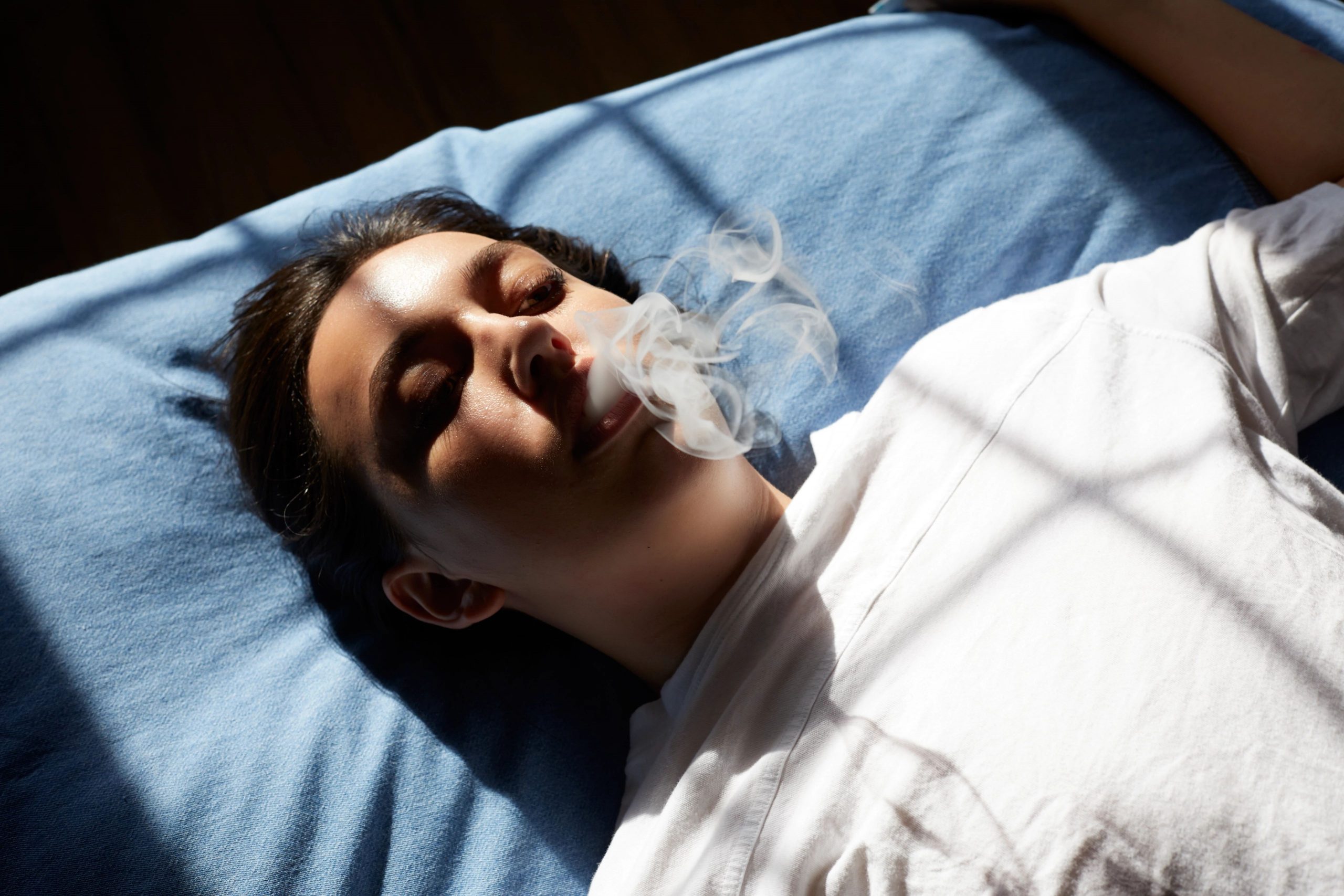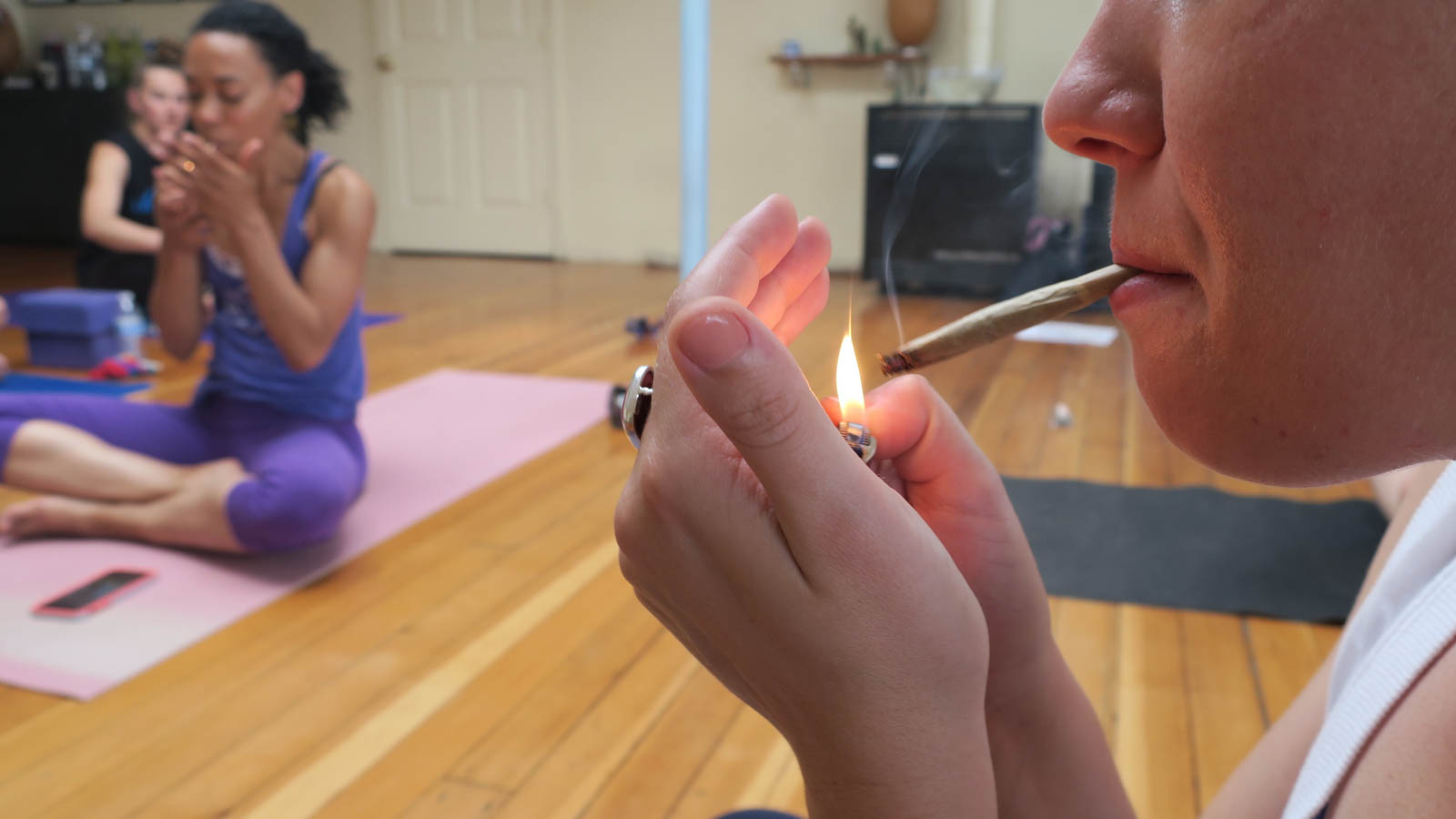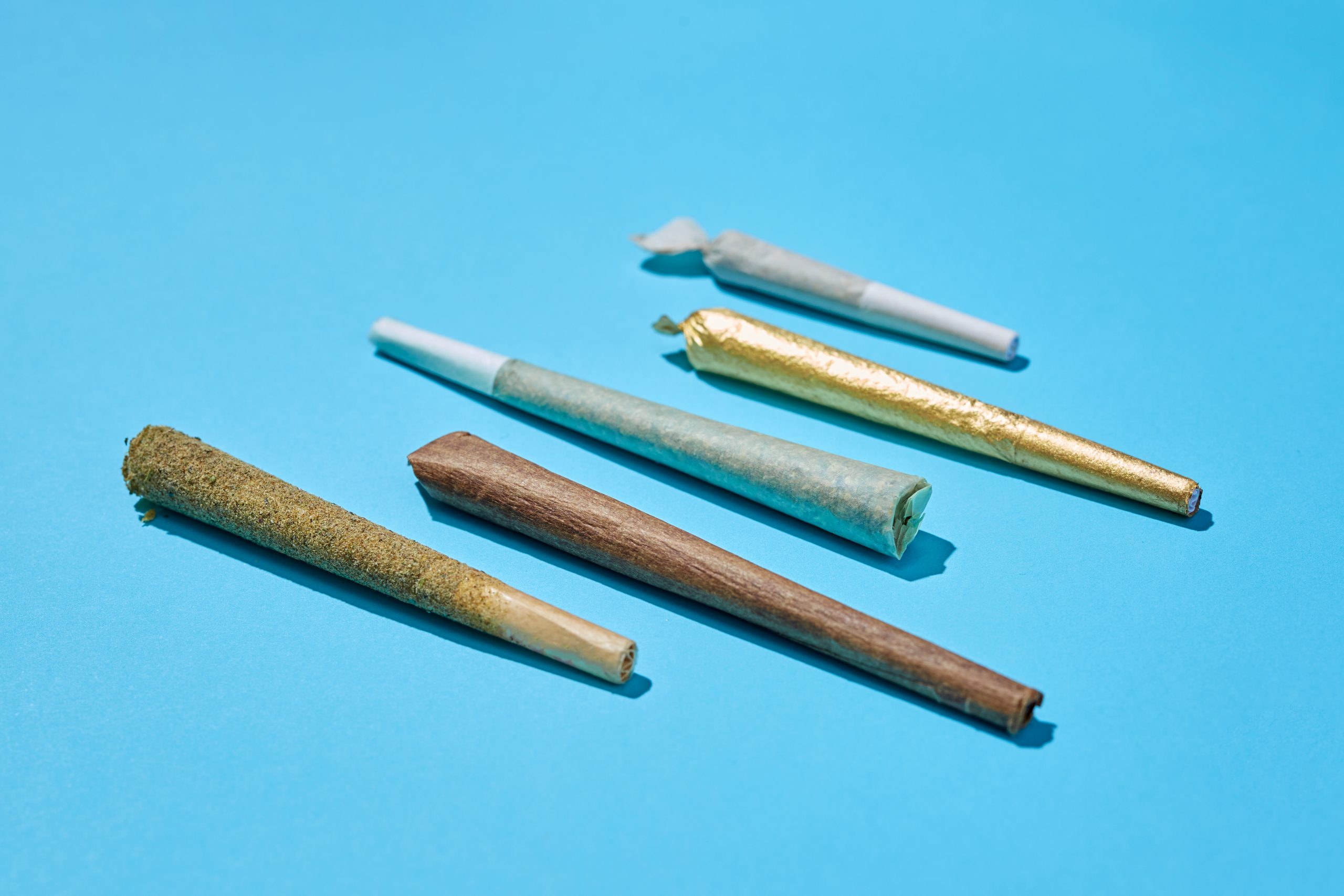Science & medicine
Marijuana Helps People Quit Using Prescription Sleep Aids And Allows Them To Wake Up More Focused And Refreshed, Study Indicates
Published
1 year agoon
By
admin
A new survey of cannabis consumers with sleep issues found that most preferred to use marijuana instead of other sleep aids to help get to bed, reporting better outcomes the next morning and fewer side effects. Smoking joints or vaping products that contained THC, CBD and the terpene myrcene were especially popular.
Compared to using conventional sleep aids or no sleep aids at all, respondents reported that cannabis made them feel more refreshed, focused and better able to function the morning after, with fewer headaches and less nausea. But they also reported some side effects from marijuana use, including waking up feeling sleepy, anxious and irritable.
The study, conducted by a pair of psychology researchers at Washington State University (WSU), was published late last month in the journal Exploration of Medicine. Authors say they believe it’s the first research comparing cannabis to prescription sleep aids (PSAs) and over-the-counter (OTC) sleep aids.
“In general, the use of cannabis for sleep-related issues was perceived as more advantageous than over-the-counter medications or prescription sleeps aids,” Carrie Cuttler, a WSU professor and one of the study co-authors, said in a press release on Monday. “Unlike long-acting sedatives and alcohol, cannabis was not associated with a ‘hangover’ effect, although individuals reported some lingering effects such as sleepiness and changes in mood.”
The WSU researchers surveyed 1,216 people for the study using the medical marijuana app Strainprint. Nearly two thirds (64.9 percent) of participants reported that they’d been suffering from sleep issues for at least five years, while nearly 70 percent said they’d been using cannabis to help with sleep for at least a year. A plurality of respondents (38 percent) said they’d been using marijuana for sleep for between one and three years.
Nearly 82 percent of the cannabis consumers said they do not currently use prescription or over the counter sleep medications, though more than half reported doing so in the past, indicating that they have some to see marijuana as a better option.
More than half the sample reported that they use cannabis every night to help fall asleep. Most respondents said they either smoke joints (46.1 percent), vape flower (42.6 percent) or use some form of cannabis oil (42.5 percent) before bed, although nearly a third said they use edibles and/or vape pens. Another 14.6 percent said they use cannabis in capsule form.
While inhaled forms of cannabis tend to be more popular among most consumers in general, authors said that those with sleep issues may prefer smoking and vaping “because of the short latency of onset with inhalation and the high percentage of respondents who indicated difficulty falling asleep.” They said they were surprised that edibles or capsules weren’t more popular “as these are longer lasting and as such may be more beneficial for maintaining sleep.”
In terms of product makeup, most respondents used high-THC products (60.0 percent), although 21.7 percent opted for a balanced THC–CBD blend. Asked about cannabinoids used for sleep, 78.8 percent said choose THC, 47.1 percent said CBD and 18.1 percent pointed to CBN.
As for terpenes, myrcene was the most popular (49.0 percent) followed by linalool (26.9 percent), limonene (24.7 percent) and beta caryophyllene (19.1 percent).
“One of the findings that surprised me was the fact that people are seeking the terpene myrcene in cannabis to assist with sleep,” Cuttler said in the WSU press release. “There is some evidence in the scientific literature to support that myrcene may help to promote sleep, so cannabis users seemed to have figured that out on their own.”
Asked to report how cannabis helps with their sleep, respondents said it relaxed their body (81.0 percent) and mind (83.0 percent), helped prevent interruptions in sleep (36.3 percent) and promoted a deeper (56.2 percent), longer (41.6 percent) sleep.
Of the 526 people who reported using prescription and OTC sleep aids in addition to marijuana, “significantly more reported that they feel more refreshed, more focused, and better able to function in the morning after using cannabis relative to OTC sleep aids, PSAs, or no sleep aids. Participants also reported fewer headaches and less nausea the morning after.”
“Participants reported feeling more refreshed, focused, better able to function, fewer headaches, and less nausea the morning after using cannabis for sleep than after using more conventional sleep aids or no sleep aids.”
Among those who used all three types of sleep aids, the report continues, “significantly more participants reported that they experience nausea, anxiety, and racing heart when using OTC sleep medications or PSAs compared to cannabis.”
Some side effects reported by participants are no surprise. Cannabis was more likely than other sleep aids, for example, to cause a dry mouth and red eyes. Other unintended consequences, however, were more noteworthy. For example, “significantly more participants endorsed feeling more sleepy, more anxious, and more irritable the morning after using cannabis relative to other sleep aids or no sleep aids,” the study says.
Those findings align with takeaways from past research that marijuana use can lead to longer sleep durations and fewer middle-of-the-night awakenings, but also more next-day fatigue.
Notably, researchers found that more than 60 percent of study participants reported getting six to eight hours of sleep when they used cannabis alone. Less than 20 percent, however, reported getting six to eight hours of sleep when using a prescription or OTC sleep aid, regardless of whether it was used in combination with marijuana.
“Overall the literature suggests that cannabis can be beneficial for some aspects of sleep,” authors wrote, “however, additional objective research is needed to determine which aspects of sleep are positively affected and which are negatively affected by cannabis.”
Despite marijuana’s potential side effects, researchers said they might be more tolerable for participants than side effects of other, more traditional sleep aids.
“These side effects may be less severe or impairing than the side effects they experience with other sleep aids,” the study says, “and therefore, contribute to the perception that cannabis is superior to more conventional sleep aids.”
Authors noted that their survey had a strong selection bias toward people who were already using cannabis because they perceive it to be helpful. “Not everyone is going to find that cannabis helps with their sleep,” Cuttler said in a statement, “and future research needs to employ more objective sleep measures to provide a more comprehensive understanding of the effects of cannabis for sleep.”
Quality of sleep often arises in other studies into the potential benefits of marijuana, and generally, consumers say it enhances their rest. Two recent studies, for example—one involving people with chronic health conditions and another looking at people diagnosed with neurological disorders—found that sleep quality improved with cannabis use.
A 2019 study, meanwhile, found that people tended to purchase fewer OTC sleep medications when they have legal access to marijuana. In particular, authors of that study noted, “cannabis appears to compete favorably with OTC sleep aids, especially those containing diphenhydramine and doxylamine, which constitute 87.4% of the market for OTC sleep aids.”
You may like
-


ILGM’s Home Grow Tour 2025
-


Karma Koala Podcast 238: Daniel Shortt Launches New Firm With Partner Perry Salzhauer In Pacific NW
-


Trump invites former cannabis prisoner to speech, but doesn’t mention cannabis (Newsletter: February 5, 2025)
-


Buddha Chief raises vibrations at new Housing Works dispensary in NoMad
-


3 best THCA vape carts of 2025 by Leafly
-


From client to co-founder, Storz & Bickel executive on US tour to drum up cannabis business
Culture & industry
Traffic Death Rates Fell In States That Legalized Marijuana, New Study Finds, While Those That Kept Criminalization Saw ‘Slight Increase’
Published
1 year agoon
October 26, 2023By
admin
States that legalized marijuana in 2016 saw meaningful declines in traffic fatalities during the years immediately following the policy change, according to a new study by Quartz Advisor. Takeaways were less clear, however, over a longer period of time that included years the report describes as “anomalies” nationwide.
Ultimately, the paper concludes, motor vehicle safety “should not be a significant concern for marijuana legalization initiatives,” especially when measured against alcohol.
“As of yet, studies have failed to show that legalization of cannabis has resulted in any significant increase in traffic fatalities in the places where it has been legalized,” it says. “However, the same cannot be said for alcohol, an intoxicant that remains legal, widely available, and deeply ingrained in our culture.”
In states that legalized marijuana, “traffic fatalities declined or remained the same in the three years that followed, compared to a slight increase in states where it remained illegal.”
The findings, which are not peer-reviewed, examined traffic fatality data from four states that legalized adult-use cannabis in 2016: California, Maine, Massachusetts, and Nevada. Quartz Advisor then compared those states’ vehicle death rates to the national average as well as to rates in five states where marijuana remained illegal during that period: Idaho, Indiana, Kansas, Nebraska, and Wyoming.
In the three years following the change, the report says, none of the four legalized states saw an increase in traffic deaths. Most, in fact, saw declines.
“Three of four the four states saw a significant decrease in vehicle deaths over that span,” the paper says, “while the rate in Maine showed no change. Massachusetts saw the biggest drop, as rates fell 28.6 percent in the three years following legalization.”
Combined, the four states that legalized marijuana saw an 11.6 percent drop in traffic death rates from 2016 to 2019. That’s a sharper decline than the national average, which fell 10.6 percent over the same period.
That’s a far better outcome than in the five states the report examined where marijuana remained illegal, which together experienced a 1.7 percent increase in their combined traffic death rate from 2016 to 2019.
What might seem like a clear picture, however, gets muddier when researchers expanded the analysis to include data from 2020 and 2021, the most recent years for which National Safety Council (NSC) numbers were available. Over that period of time, the vehicle death rate in fact rose in states that legalized marijuana, although less than in the U.S. as a whole. The states where cannabis was illegal, meanwhile, saw vehicle fatality rates dip.
“Among the states that legalized marijuana in 2016, the vehicle death rate increased by 6.0 percent between 2016 and 2021,” the report says. “While this is an increase, it is slightly less of an increase than the national average, which saw a 6.2 percent increase in the traffic fatality rate over the same period. The vehicle death rate dropped by an average of 0.7 percent in the five states that have not legalized cannabis during this period.”
Why consider ignoring two entire years of data? The report explains:
“In many ways, 2020 and 2021 were anomalies, and this remains true in the vehicular accident trends. After decades of declining accident rates in the U.S., traffic fatalities picked up in 2020 and stayed high through 2021. The U.S. as a whole saw traffic fatality rates spike 18.9 percent from 2019 to 2021. States that legalized marijuana in 2016 saw a similar increase of 19.9 percent. States that have not legalized—and are notably more rural than ones that did—saw the vehicular death rate fall 2.3 percent over that period.”
“Because of this, we thought it was important to see what rates looked like with 2020 and 2021 removed from the data set,” it continues. “And it turns out, they look quite different.”
Quartz Advisor called the set of observations “interesting and nuanced—but ultimately limited.” So the publication talked to Judi Watters, public information and consumer outreach for the Maine Bureau of Insurance, who cited a Casualty Actuarial Society report from December 2022 that examined data from the U.S. and Canada from 2016 to 2019.
“The tests for the decriminalization effect on fatalities failed to detect a statistically significant change,” the 2022 report says about its U.S. findings. Similarly, the analysis “showed no statistically significant changes in the average cost per claim and claim frequency after marijuana legalization in Canada.”
The new Quartz Advisor report says that “while there is no evidence to suggest that legalizing or decriminalizing marijuana makes roads more dangerous, that is not to say that it is safe to drive while under the influence of cannabis.” It references a 2010 meta-analysis published in The American Journal of Addictions that found marijuana “causes impairment in every performance area that can be reasonably connected with safe driving of a vehicle.”
Oddly, however, that doesn’t always seem to make driving behavior commensurately more dangerous.
The 2022 Casualty Actuarial Study found that while marijuana use does affect driving, “the behavior is not always riskier; for example, slower speeds and longer following distances of impaired drivers have been reported.”
The American Journal of Addictions report includes a similar caveat:
“Surprisingly, given the alarming results of cognitive studies, most marijuana-intoxicated drivers show only modest impairments on actual road tests,” it says. “Experienced smokers who drive on a set course show almost no functional impairment under the influence of marijuana.”
Looming over popular concerns about cannabis-impaired driving is the fact that there exists no reliable test to screen for cannabis impairment specifically. Standard drug tests make it difficult or impossible to know whether someone is under the influence of marijuana or consumed it days or even weeks ago.
This summer, a report in Congress for the Transportation, Housing and Urban Development, and Related Agencies (THUD) bill said that the House Appropriations Committee “continues to support the development of an objective standard to measure marijuana impairment and a related field sobriety test to ensure highway safety.”
In February, the head of the American Trucking Association (ATA) discussed the problem with a congressional committee, arguing that lawmakers need to “step up” to address the conflict between state and federal cannabis policy as the industry faces shortages.
Tens of thousands of commercial truckers are testing positive for marijuana as part of the federally mandated screenings, data from the Department of Transportation (DOT) show.
Sen. John Hickenlooper (D-CO) sent a letter to DOT last year seeking an update on the status of a federal report into research barriers that are inhibiting the development of a standardized test for marijuana impairment on the roads. The department is required to complete the report by November under a large-scale infrastructure bill that President Joe Biden signed.
Experts and advocates have emphasized that evidence isn’t clear on the relationship between THC concentrations in blood and impairment.
A study published in 2019, for example, concluded that those who drive at the legal THC limit—which is typically between two to five nanograms of THC per milliliter of blood—were not statistically more likely to be involved in an accident compared to people who haven’t used marijuana.
Separately, the Congressional Research Service in 2019 determined that while “marijuana consumption can affect a person’s response times and motor performance … studies of the impact of marijuana consumption on a driver’s risk of being involved in a crash have produced conflicting results, with some studies finding little or no increased risk of a crash from marijuana usage.”
Another study from last year found that smoking CBD-rich marijuana had “no significant impact” on driving ability, despite the fact that all study participants exceeded the per se limit for THC in their blood.
This article originally appeared on Marijuana Moment.
Culture & industry
Study On Marijuana Use And Yoga Finds That Set And Setting Can Influence Mental Health Benefits
Published
1 year agoon
October 23, 2023By
admin
A newly published study finds that people who practice yoga after consuming marijuana experience improved mindfulness and mysticality, indicating that setting and behavior may play an important role in modulating a person’s cannabis experience.
The paper, published as a University of British Columbia psychology dissertation, aimed to explore “the impact of contextual factors during cannabis use on well-being outcomes.” As author Sarah Elizabeth Ann Daniels wrote, such considerations are common in the realm of psychedelic therapy but less so when it comes to cannabis.
“When using other psychoactive drugs to treat mental health conditions, researchers pay particular attention to contextual factors beyond the direct drug effects, such as the mindset, setting, and behavior, as there is considerable evidence that these factors can significantly impact the therapeutic outcomes,” Daniels observed. “These factors are rarely considered during therapeutic cannabis use.”
The study’s results “generally indicate that what you do while you experience cannabis effects matters,” the paper concludes. “Mirroring psychedelics, this study supports the concept that set and setting during cannabis use may significantly impact the therapeutic benefit of the drug.”
To test whether context affected someone’s cannabis experience, Daniels had 47 participants self-administer cannabis twice, one week apart. During one session, they practiced yoga. During the other, they did whatever they’d normally do when high. The most common activities were eating, watching TV or movies, doing housework, socializing, and participating in hobbies.
Participants were scored on measures including “state mindfulness,” “mysticality of experience,” and “state affect.”
State mindfulness measured “both traditional Buddhist and contemporary psychology models of mindfulnesses,” including awareness of both mental states and bodily sensations. Mystical experience, meanwhile, referred to feelings of experiencing eternity or the infinite, a sense of peace and tranquility, or a loss of one’s usual perception of time.
Daniels found significant improvements in respondents’ reported mindfulness when they practiced yoga with cannabis. Their mysticality of experience was also greater, even though Daniels acknowledges that mysticality is more traditionally associated with psychedelic substances. “While cannabis is not considered a traditional psychedelic,” she writes, “recent evidence indicates that it shares many commonalities with psychedelic-induced altered states.”
As for state affect—essentially one’s emotion and mood—no significant difference emerged between yoga and non-yoga sessions.
Studying the impact of set, setting, and other variables the paper refers to as “extra-pharmacological factors” is crucial to understanding the therapeutic potential of cannabis, Daniels writes, noting that accounting for such factors helped clarify early research about psychedelics.
“Much like studies of cannabis today, studies of psychedelics in the 1960s were producing wildly variable results,” the report says. “Researchers at the time began to explore and document the impact of set and setting on the subjective drug effects, and how outcomes could be influenced by extra-pharmacological factors became a crucial consideration in studies of the effects of psychedelics and psychedelic psychotherapy. Indeed, once set and setting was attended to, recorded psychedelic experiences shifted from overwhelmingly negative to overwhelmingly positive.”
Seventy-two percent of participants (34) said they’d mix cannabis and yoga again. Not only did yoga seem to make their cannabis experience better, but cannabis also seemed to enhance their enjoyment of their yoga practice:
“The most frequently reported theme was enhanced physical awareness (n = 15), which captured an increased awareness of the body, movement, and physical sensory experiences. For example, participants reported they were more ‘in touch’ or ‘in tune’ with their body and their body’s needs, and felt their body, sensations, and sense of movement on a ‘deeper’ level. They particularly emphasized that this was different from their usual (sober) experience of yoga, stretching, or physical activity and that this experience represented a gain or a change from their experiences without cannabis.”
Six participants had never practiced yoga before, while 30 said they practiced “rarely or sometimes.” Another 11 said they did yoga often or very often.
“These findings suggest that paying attention to contextual factors and providing guidelines for therapeutic cannabis users may improve clinical outcomes when using cannabis to support mental health and well-being,” Daniels wrote.
The results could have implications for how to best tap into cannabis’s potential benefits—or even avoid potential risks. “Physicians have long described a knowledge gap pertaining to best practices when prescribing cannabis for therapeutic purposes,” the report says. “Providing specific behavioral directions as well as psychoeducation on the role of set and setting may stand to maximize benefits and minimize harms of therapeutic cannabis use. Based on the high degree of acceptability of the yoga intervention, yoga or similar mindful movement may be a useful recommendation.”
Daniels also suggested that the feeling of being “high” shouldn’t be discounted among researchers seeking to understand how cannabis works.
“A typical trend in the pharmaceutical field when developing medications based off of traditional psychoactive plant medicines (i.e., cannabis, psychedelics) is to seek to remove the psychoactive effects. The focus is often on a biological mechanism while the ‘high’ is seen as an undesired side effect,” the study says. “The results of the current study provide more evidence to support the intrinsic therapeutic value found in the altered states of consciousness occasioned by such psychoactive drugs.”
The U.S. government itself has named the consciousness-altering potential of psychedelics as one of their major side effects. A $27-million project announced in 2020 by the U.S. Department of Defense’s Defense Advanced Research Projects Agency (DARPA), for example, was intended to work toward the development of pharmaceuticals that worked similarly to psychedelics but without “significant side effects, including hallucination.”
Pairing marijuana and yoga, meanwhile, is nothing new in the cannabis community. Classes combining the two have been around since at least the early years of state-level legalization, and likely much longer. However, the reported benefits of those activities have been mostly anecdotal.
Back in 2018, U.S. Rep. Nancy Pelosi (D-CA) even recommended marijuana and yoga (done separately, however) as alternatives to opioids. “Marijuana, yoga, all kinds of other things that are homeopathic but are not addictive in this dangerous way,” she said.
This article originally appeared on Marijuana Moment.
Featured
What is the scientifically best way to roll a joint?
Published
1 year agoon
October 19, 2023By
admin
How do you get as high as possible? It’s an age-old question that has consumed weed smokers, growers, researchers, scientists, and anyone who’s ever put some kind bud to their lips since humans first discovered the plant.
Recently, a study came out on the best way to roll a joint and get the highest concentration of cannabinoids. We’ve read, questioned, and tested it to see if there’s any validity to the study’s findings.
What is the best way to roll a joint?
You’d think that reaching certain degrees of high is a numbers game around buying weed with the highest percentage of THC possible — but it’s not. Scientists reported in a study by Scientific American that, with joints, how high you get is largely defined by how the joint was engineered, from how the weed was broken down and rolled to how the joint burns.
They broke the weed down by different weed particle sizes and hand-rolled the joints to test it. Then, they measured what percentage of cannabinoids reached the end user’s lips and bloodstream. The results alleged that the quality of a joint and getting the most cannabinoids and compounds per puff is about the size of the weed particles after grinding them, the roll quality, and how evenly the final product burns.
The study was headed by Markus Roggen, president and chief science officer of Delic Labs, a cannabis and psilocybin research facility in Vancouver, British Columbia. Roggen and his colleagues questioned whether cannabinoid concentration was the most important factor in determining cannabis’s intoxicating effects and what other factors contribute to an enjoyable experience.
The team of scientists crafted a study where a smoke machine puffed on three pre-rolled paper cones in the same capacity and then measured the volume of cannabis compounds that were delivered. They used a coffee grinder and sieve to grind the cannabis and then hand-rolled the joints. The samples had weed particles that were one millimeter, three millimeters, and five millimeters in diameter.
They made joints from half-gram samples of each and used a “smoke cycle simulator” that inhaled six times for three seconds before exhaling. Filters collected the aerosols at the machine’s 3D-printed mouthpiece, and the researchers used analytical chemistry techniques to measure aerosol levels from puffs taken at the beginning, middle, and end of each joint.
How did we roll the “best” joints possible?
I used this chart to determine what kind of sieve to purchase to get the particle size right. Then I hit Amazon for the cops:
Note: smoking by particle size requires way too much work, and I know you aren’t going to put that effort in. But we did, ya know, for science. However, human trial and error greatly affects variable results in this experiment.
Before testing, I knew the best time to smoke would be in the morning while I was completely sober, so I spaced the samples out between Tuesday, Wednesday, and Thursday mornings. The original study agreed that a human volunteer could not assess this many samples back-to-back with accurate results.
Step 1
I used a red Solo cup and a basic kitchen scale to weigh 0.5-gram samples of LA Cherry Runtz from Flight Path. I rubbed them against the sieves to break down the weed.
Step 2
I hand-rolled the samples into 1.4-inch OCB Virgin Cones.
Step 3
I inhaled.
During the smoke, I hit each joint six times for three “Mississippis” — the true way to count seconds, just as the study suggested. I jotted my journey over the following three hours to remember and compare the feelings.
Results
Ultimately, I know what you’re wondering: Could I really tell the difference between the highs based on particle size? Unfortunately, no, I could not. I just got high like any other time I’ve smoked a lil’ half-grammer.
When using different sieves for different particle sizes, I did not detect a higher high between a joint rolled with 1mm and 5mm particles. Perhaps some sort of monitor would have suggested differently, but if we’re going off of a human test and human feelings, it simply wasn’t there.
What does this study mean for the future of joints?
As of right now, nothing. Weed companies are not about to start marketing products based on particle size in a world where they are still fighting the THC percentage and indica vs sativa vs hybrid battles. But the information is still nice to know.
Amber Wise, scientific director of the cannabis testing lab Medicine Creek Analytics, said, “Roggen’s data supports the argument that THC percentage matters less than particle size, and pre-roll manufacturers will find this useful.” According to Scientific American, the study concluded that further progress would require addressing variability that persisted in the team’s measurements — even between identically prepared joints.
In future work, Roggen and his colleagues plan to examine how other factors, including humidity, combustion source, and packing density, influence a joint’s architecture and effects. We’ll be around to test those findings, too.

ILGM’s Home Grow Tour 2025

Karma Koala Podcast 238: Daniel Shortt Launches New Firm With Partner Perry Salzhauer In Pacific NW
Trump invites former cannabis prisoner to speech, but doesn’t mention cannabis (Newsletter: February 5, 2025)

Buddha Chief raises vibrations at new Housing Works dispensary in NoMad

3 best THCA vape carts of 2025 by Leafly

From client to co-founder, Storz & Bickel executive on US tour to drum up cannabis business

UNDERSTANDING CANNABIS AND CANNABINOIDS (THC and CBD)

The Rise and Fall of the Cannabis Industry

High Stakes and High Demand: Will Las Vegas Finally Allow Cannabis Near Casinos?

Cannabis Tourism in 2025: Destinations, Trends, and Tips

Distressed Cannabis Business Takeaways – Canna Law Blog™

United States: Alex Malyshev And Melinda Fellner Discuss The Intersection Of Tax And Cannabis In New Video Series – Part VI: Licensing (Video)

What you Need to Know

Drug Testing for Marijuana – The Joint Blog

NCIA Write About Their Equity Scholarship Program

It has been a wild news week – here’s how CBD and weed can help you relax

Cannabis, alcohol firm SNDL loses CA$372.4 million in 2022

A new April 20 cannabis contest includes a $40,000 purse

Your Go-To Source for Cannabis Logos and Designs

UArizona launches online cannabis compliance online course
Trending
-

 Cannabis News2 years ago
Cannabis News2 years agoDistressed Cannabis Business Takeaways – Canna Law Blog™
-

 One-Hit Wonders2 years ago
One-Hit Wonders2 years agoUnited States: Alex Malyshev And Melinda Fellner Discuss The Intersection Of Tax And Cannabis In New Video Series – Part VI: Licensing (Video)
-

 Cannabis 1012 years ago
Cannabis 1012 years agoWhat you Need to Know
-

 drug testing1 year ago
drug testing1 year agoDrug Testing for Marijuana – The Joint Blog
-

 Education2 years ago
Education2 years agoNCIA Write About Their Equity Scholarship Program
-

 Cannabis2 years ago
Cannabis2 years agoIt has been a wild news week – here’s how CBD and weed can help you relax
-

 Marijuana Business Daily2 years ago
Marijuana Business Daily2 years agoCannabis, alcohol firm SNDL loses CA$372.4 million in 2022
-

 California2 years ago
California2 years agoA new April 20 cannabis contest includes a $40,000 purse



